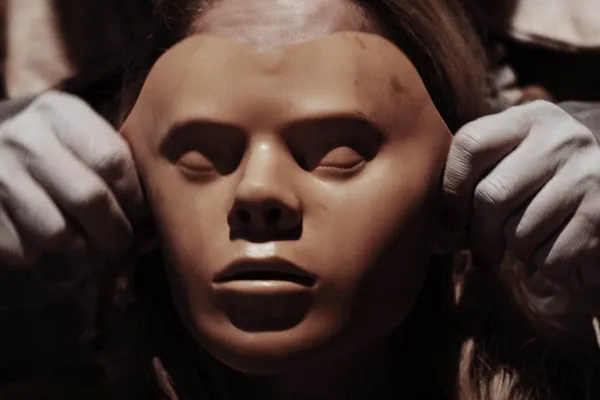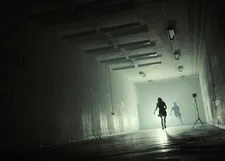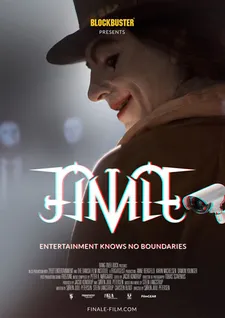 |
| Masked-up in Finale Photo: Glasgow Film Festival |
Darkness is falling on a lonely road outside town. With Denmark unexpectedly through to the finals, practically everybody is watching the game tonight, and petrol station employees Agnes (Anne Bergfeld) and Belinda (Karin Michelsen) are expecting their shift to be quiet. What they don't know is that they've attracted the attention of a sinister organisation and with no customers, there will be no witnesses.
This is the premise of Søren Juul Petersen's Finale (aka The Ringmaster), showing in the Frightfest strand at this year's Glasgow Film Festival. In the run-up to the screening, the first-time director agreed to answer some questions about the origins of the film and the way it developed onscreen.
We began with the theme of games and I asked if the way that people can become obsessive about watching games was an important theme for him. Did he see it as part of the reason why Agnes and Belinda end up in the situation that they do?
"Yes, you could say that there are two different kinds of games in Finale: the legal game being the football finals that occurs during the nightshift of the two girls - and the more illegal game; being the Dark Web based entertainment game in the basement of the old abandoned hospital.
"Actually, the two story-tracks are taken from an award-winning book by Steen Langstrup (the Danish Stephen King) where the non-linear story also originates from. When I read the novel, I was struck by how cinematic that structure was. So, it was a thing I really wanted to have in the film as well.
 |
| Running for it Photo: FrightFest |
"I also knew that in order to keep up the tension and suspense in the film, we had to have the same basic structure. Reducing the film to a more linear structure could have slowed down the film. The other good thing about having a two-storylines-structure is that the audience can have a pause and get away from the hardcore scenes a couple of times as we know that a couple of scenes are quite heavy to cope with – at least for most mainstream audiences." He smiles. "So right from the start it was important to me that we made a point with the film – How far do you go in your entertainment eagerness – What are the boundaries of good entertainment?"
Did he want to explore issues around the Dark Web, what can happen there, and what that reveals about human nature?
"Yes – Dark Web was definitely something which is interesting right from the start – and it really grew on me during the production of Finale.
"You can actually say that Finale is a 'what-If' film'
"Suppose an organisation like 'Escapismus' in the film indeed existed? An organisation that offered the ultimate entertainment: Experiencing other people's suffering and death in real time. Human history has proved that the demand is there; Gladiator matches in Rome, slave fights in southern US states, Russian roulette in Vietnam. Examples that all have been filmed!
"Civilised man has of course over the last several decades morally worked to stop this. But the Dark Web’s possibilities of anonymity with a Tor browser and a handful of Bitcoins has now opened the locks even more for this kind of gloomy entertainment business. So, I’ll not at all be surprised, if entertainment shows in the pitch-black bottom of the dark Internet will appear in the future– real-time circus you can access, behind encrypted protection.
"Over the last three years, while producing Finale, reality here in Scandinavia has almost surpassed - or at least confirmed - the themes in the film. We have seen the story of an old gentleman who ordered video-filmed-rape of children in the Philippines, Peter Madsen and the U-boat case, the case of the 1,000 Danes who as a fun entertainment spread a sex-video of a minor, and we have witnessed the despicable Danish woman who ordered the assassination of her ex-husband on the Dark Web."
We go on to talk about the casting process for Finale.
"I knew that I wanted two not-yet-known-actresses. And as there is a good load of acting talent here in Denmark – I started early in the process scouting for two new fresh faces myself. This also took me to the acting school Ophelia here in Copenhagen. Though some friends I was introduced to Anne who was preparing her final exam on stage. I saw her performance and liked it – and she reminded me of Ingrid Bergman, beautiful and a bit reserved - and as she was half German too, she suited perfectly as Agnes (the film takes place close to the border of Germany). We talked and agreed that we needed to do a casting. Because I had to be convinced that she really could be very frightened and be able to scream convincingly. We then did the casting - and boy! - she prepared herself in make-up for about ten minutes in a complete dark room. Then we tied her up in a chair. And when I said ‘Action,’ she screamed and begged for her life in such a convincing way, that I gave her the part immediately. I think it took five minutes.
 |
| Screaming like she means it Photo: FrightFest |
"As the two actresses needed to be together over a long period during the production (we shot in four blocks over three months), we needed the ‘Belinda’ character to be someone who Anne could bond well with – also outside the shooting. Then Anne pointed towards Karin who was a friend and student from the same school. Karin looked very much like the ‘Belinda’ I had imagined, and she also had a ‘Belinda-background’ growing up in a farm environment in the country. We did a couple of scenes between Agnes and Belinda in the back-room of the petrol station and they suited each other – they just had good chemistry. But when we soon after did a casting session between Karin and her boyfriend in the film (played by Mads Koudal), I was completely convinced Karin was ‘Belinda’."
The women seem used to having to deal with strange and obnoxious customers when working at the petrol station. Has he ever worked in a job like that?
"Actually no – I’ve never had to work in isolated places during nightshifts or dealing with obnoxious customers myself. It’s all fiction taken from the novel. And I know that Steen Langstrup hasn't worked in places like that either, but I’m sure it can be quite scary to work in a place like that once in a while."
The tone of the scenes in the petrol station is very different from the scenes we see later. Did he set out to shoot them in a different style, and if so, how did that affect his shot choices?
"It’s quite deliberate that the tone is a bit different. That’s also taken from the novel.
"After many years as a producer, I knew that we needed to break the production phase into several location-phases in order to be able to get a variation in the tone. And that also gave us an advantage in getting a low budget film to look like a bigger budget film. It was like: instead of preparing running a marathon where your cast and crew after half the distance naturally slow done and the look of the feel will not vary - we prepared for four times 10 km with quite high tempo – so to speak.
"But overall, I wanted Finale to have a cinematic fell to it. I wanted Finale to look like the films I like and admire despite us only having a catering budget of a Hollywood film. So; handheld low budget style was forbidden. Every scene had to embrace ‘Cinematic Storytelling’, which in my book is where the images and sound tells the story and not just the camera picking up on people talking or running around.
 |
| Finale poster Photo: FrightFest |
"All in all, we tried to avoid the main prejudices that low budget filmmaking equals ‘Handheld camera with bad sound’."
With scenes like these, it's always a challenge to make them stand out from those in other horror films. How did he work with his special effects team to achieve that?
"It’s normally quite difficult to get violent scenes unique – especially if you don’t have a good budget for it. But from the start we talked to the main financier; The Danish Film Institute, about it and they were very insistent on us putting ‘the pedal to the metal’ as they expressed it. Because with in recent years DFI had supported a couple of horror films that didn’t ‘deliver the goods’ so to speak.
"But to start out with I was in doubt about how expressionistic we should do it – and not only because of the budget but also personally - as I’m a bit of a wimp myself.
"But we ended up preparing quite well; we got hold of Martin Hansen, a fantastic SFX make-up artist and a young multitalented stuntman called Anders Nylander Thomsen. And together with my DOP Tobias Scavenius, the four of us talked it though many times and we planned extra schedule time for the most violent sequences in the film. We did have several different horror films benchmarked against Finale, so we knew when we were leaning against them and when we were leaning away from them. And early in planning I sensed that we would create something of our own. Actually, I stepped back several times during the shooting of those scenes. Simply because I could see that my team was pushing the limits of their abilities and I could sense this was going to be good.
How does he feel about the film being selected to screen at Frightfest in Glasgow?
"I’m very very excited about it. I know that FrightFest is one of the most important genre festivals in the world and I know how much competition there is, getting your film though the eye of that horror-needle – so I’m also humble at the same time, I think…"
Finally, what's next for him as a filmmaker?
"I have several projects I’m working on right now but as I’m a big fan of UK writer Kim Newman, my eyes are a bit fixed on his work. So, let’s see – otherwise I’m very open to any opportunity that jumps out of Finale getting screened around the world…"
Finale is screening in Glasgow on Saturday 2 March.





















